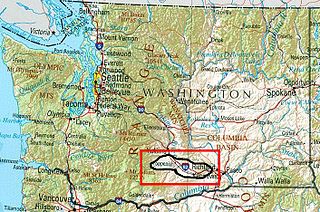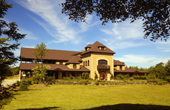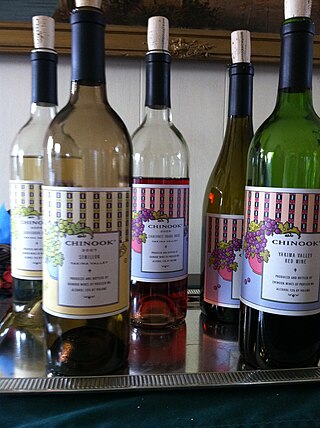
Cabernet Franc is one of the major black grape varieties worldwide. It is principally grown for blending with Cabernet Sauvignon and Merlot in the Bordeaux style, but can also be vinified alone, as in the Loire's Chinon. In addition to being used in blends and produced as a varietal in Canada and the United States, it is sometimes made into ice wine in those regions.

Petit Verdot is a variety of red wine grape, principally used in classic Bordeaux blends. It ripens much later than the other varieties in Bordeaux, often too late, so it fell out of favour in its home region. When it does ripen it adds tannin, colour and flavour, in small amounts, to the blend. Petit verdot has attracted attention among winemakers in the New World, where it ripens more reliably and has been made into single varietal wine. It is also useful in 'stiffening' the mid palate of Cabernet Sauvignon blends.

Stag's Leap Wine Cellars is a winery founded by Warren Winiarski in 1970 and based in the Stags Leap District of Napa Valley, California.
André Viktorovich Tchelistcheff was America's most influential post-Prohibition winemaker. Tchelistcheff is most notable for his contributions toward defining the style of California's best wines, especially Cabernet Sauvignon. Called the "dean of American winemakers", industry pioneers, such as Rev. John Staten of Field Stone Winery, Robert Mondavi, Louis Martini, Rob Davis of Jordan Vineyard & Winery, Joel Aiken, Michael Silacci of Opus One, Greg La Follette, of Ancient Oak, and Rick Sayre of Rodney Strong Wine Estates, considered him their mentor. Andre advised Warren Winiarski in launching Stag's Leap Wine Cellars which famously made the 1973 SLV Cabernet Sauvignon that was awarded the most points in the ”Judgement of Paris” wine tasting in 1976. Andre also assisted Ste. Michelle Wine Estates in launching the Anthology program at Conn Creek Winery in 1991.

Washington wine is a wine produced from grape varieties grown in the U.S. state of Washington. Washington ranks second in the United States in the production of wine. By 2017, the state had over 55,000 acres (220 km2) of vineyards, a harvest of 229,000 short tons (208,000 t) of grapes, and exports going to over 40 countries around the world from the 940+ wineries located in the state. While there are some viticultural activities in the cooler, wetter western half of the state, the majority (99.9%) of wine grape production takes place in the shrub-steppe eastern half. The rain shadow of the Cascade Range leaves the Columbia River Basin with around 8 inches (200 mm) of annual rain fall, making irrigation and water rights of paramount interest to the Washington wine industry. Viticulture in the state is also influenced by long sunlight hours and consistent temperatures.

The Yakima Valley AVA was the first American Viticultural Area established within Washington state, gaining the recognition in 1983. Part of the larger Columbia Valley AVA, Yakima Valley AVA is home to more than 18,000 acres (73 km2) of vineyards, giving the area the largest concentration of wineries and vineyards in the state. The most widely planted varietals in the area are Chardonnay, Riesling, Merlot, Cabernet Sauvignon, Pinot gris, and Syrah. Nearly 40% of Washington state yearly wine production is made from Yakima Valley grapes. In addition to grapes, the Yakima Valley is also home to several fruit orchards growing apples, cherries, nectarines, peaches, pears and plums. Around the town of Zillah, there is the Zillah Fruit Loop driving tour through the area's orchards and vineyards. The area is also home to nearly 80% of the US hop production.

The Red Mountain AVA is an American Viticultural Area that includes the land surrounding Red Mountain in Benton County, Washington. It is part of the Yakima Valley AVA, which in turn is part of the larger Columbia Valley AVA. Located between Benton City and the City of West Richland, the Red Mountain AVA is the smallest in the state at only 4,040 acres (1,630 ha) in area. The area has more than 2,000 acres (810 ha) under cultivation of primarily red varietals including Cabernet Sauvignon, Merlot, Sangiovese, Cabernet Franc and Syrah. The reputation of the wines produced in this area has brought Red Mountain AVA worldwide acclaim. The vineyards in this appellation have produced grapes for some of the most sought after wines in Washington State.

The Horse Heaven Hills AVA is an American Viticultural Area in southeastern Washington, and is part of the larger Columbia Valley AVA. The Horse Heaven Hills AVA borders the Yakima Valley AVA on the north and the Columbia River on the south. Elevations in this AVA range from 200 feet (61 m) above sea level in the south to 1,800 feet (549 m) above sea level at the northern boundary. Grapes planted in the south-facing slopes of the Horse Heaven Hills benefit from strong winds that arrive from the west via the Columbia Gorge, reducing the likelihood of rot and fungal diseases.

Texas has a long history of wine production. The sunny and dry climate of the major winemaking regions in the state have drawn comparison to Portuguese wines, in addition to other regions in Europe like Spain, France, and Italy. Some of the earliest recorded Texas wines were produced by Spanish missionaries in the 1650s near El Paso. Texas ranked as the fifth largest wine producing state by 2019.

Quilceda Creek Winery is a boutique winery in Snohomish, Washington specializing in premium Cabernet Sauvignon wine. The winery is named for a nearby creek in Snohomish County. Although the winery facility is located west of the Cascade Range, the winery sources all of its grapes from its four estate vineyards in the Horse Heaven Hills AVA and Red Mountain AVA. Quilceda Creek Winery has earned some of the highest reviews and awards of any winery in the United States and was the first American wine from outside of California to earn a perfect 100-point score from wine critic Robert Parker's publication The Wine Advocate. Since its founding in 1978, Quilceda Creek has received an additional seven 100-point scores from Robert Parker's Wine Advocate, one 100-point score from Decanter (Magazine) and two 100-point scores from acclaimed wine blog OwenBargreen.com. In addition to critics' praise, one of the highest honors for Quilceda Creek happened when President Barack Obama chose to serve their 2005 Cabernet Sauvignon Columbia Valley at a White House dinner to President Hu Jintao of China in 2011.
Foris Vineyards Winery is an American winery located near Cave Junction, Oregon in the Illinois Valley region of the Rogue Valley AVA of Southern Oregon. As one of Oregon's pioneering grape growers, Ted Gerber planted his first vineyard in 1974. For 15 years, Gerber provided fruit to other winemakers, until 1986 when the winery was founded by Ted and Meri Gerber and the Foris label was launched.

Chateau Morrisette Winery is a winery located in Floyd, Virginia. It was founded by David Morrisette in 1980, making it among the oldest wineries in Virginia. Containing 13 acres (5.3 ha) of land, the winery production has increased to approximately 60,000 cases per year.

Adelaida Vineyards & Winery is a family-owned and operated winery that was named after a 19th-century settlement in the mountains of west Paso Robles, California. Situated at 2,000 feet (610 m) of elevation and 14 miles (23 km) from the Pacific Ocean, the terrain of the Adelaida, California district is marked by ancient calcareous soils, diurnal temperature variations of nearly 50 °F (10 °C), and warm, dry growing seasons. Adelaida Vineyards & Winery produces Cabernet Sauvignon, Pinot noir, Syrah, Rhône blends, Zinfandel and other wines from the Paso Robles AVA.

Boushey Vineyard is a grape-growing estate located in the Yakima Valley AVA, north of Grandview, Washington. Grapes grown in the vineyard have been used to produce some of the most critically acclaimed Washington wines with the name Boushey regularly being featured on vineyard designated wines. Paul Gregutt, wine writer for the Seattle Times and Wine Enthusiast, list Boushey as one of the "top ten" vineyards in the entire state. The vineyard is owned and managed by viticulturist Dick Boushey who was honored in 2002 by the Washington State Wine Commission as Washington's "Grower of the Year" and in 2007 by Wine & Spirits as their "Grower of the Year". After Red Willow Vineyard, which was planted with David Lake and Mike Sauer, Boushey was one of the first Washington wine growers to plant Syrah. Today, Boushey Vineyard is considered by wine experts such as Jon Bonné to be "One of the state's top Syrah spots" with many Washington Syrahs made from Boushey's grape receiving critical acclaim.

Cecil O. De Loach Jr. is a California grape-grower and winemaker in the Russian River Valley AVA who has contributed to the reputation and notoriety of Sonoma County viticulture.

Breaux Vineyards is a Cajun owned and operated winery and vineyard located in Purcellville, Loudoun County, Virginia. Founded by E. Paul Breaux, Jr. in 1997, the 100% estate grown winery was one of three United States wineries to be named in the book "250 Best Wines 2012" by Oz Clarke for their Viognier, which landed at #87 in the publication. Breaux Vineyards is one of Virginia's largest grape growers & suppliers of wine grapes, bulk juice, and bulk wine to other East Coast U.S. wineries. The company logo is a red Crawfish, which pays homage to the Breaux family's Cajun heritage because they are often used in the local Cajun cuisine in Louisiana.

Chinook is a Washington winery located in the Yakima Valley AVA. Founded in 1983 by the wife and husband team of Kay Simon and Clay Mackey, Chinook was one of the pioneering wineries that established Prosser, Washington as a major wine-producing region in Washington state. Kay Simon, who began her career after graduating in 1976 from University of California-Davis in California's San Joaquin Valley and at Chateau Ste. Michelle, was one of the first female winemaker in Washington State. Chinook wines are widely regarded for their quality and help spread recognition for Washington wines. They are considered by wine experts such as Paul Gregutt to be "the classic expression of Yakima Valley fruit". Chinook's work with Cabernet franc, in particular, has garnered the statewide acclaim with the dry Cabernet franc rosé often described in wine reviews as a "Washington Chinon".

Red Willow Vineyard is a grape-growing estate located in the far western end of Yakima Valley AVA, within the Yakama Indian Reservation. Beginning with their relationship with Columbia Winery and Master of Wine David Lake, grapes from Red Willow have been used to produce some of the most critically acclaimed Washington wines with the vineyard's name regularly being featured on vineyard designated wines. Paul Gregutt, wine writer for the Seattle Times and Wine Enthusiast, list Red Willow as one of the "top ten" vineyards in the entire state.

Alexandria Nicole Cellars is a Washington winery that specializes in making estate wine from its Destiny Ridge Vineyard located in the Horse Heaven Hills AVA. Founded in 2001 by Jarrod and Ali Boyle, the winery expanded to include tasting rooms in Prosser, Washington and Woodinville wine country where it is housed in the historic Hollywood Schoolhouse that was built in 1912 and designated as a King County, Washington landmark in 1992. In 2011, Alexandria Nicole was named the Washington Winery of the Year by ″Wine Press Northwest″, the wine publication arm of the Tri-City Herald.

Force Majeure is a Washington/Oregon wine estate, specializing in Syrah, Cabernet Sauvignon as well as other Bordeaux and Rhone-inspired blends. The brand was founded in 2004, and beginning with that vintage Force Majeure began the "Collaboration Series" of wines made by some of Washington's top winemakers, using fruit from Red Mountain's Ciel du Cheval vineyard.




















